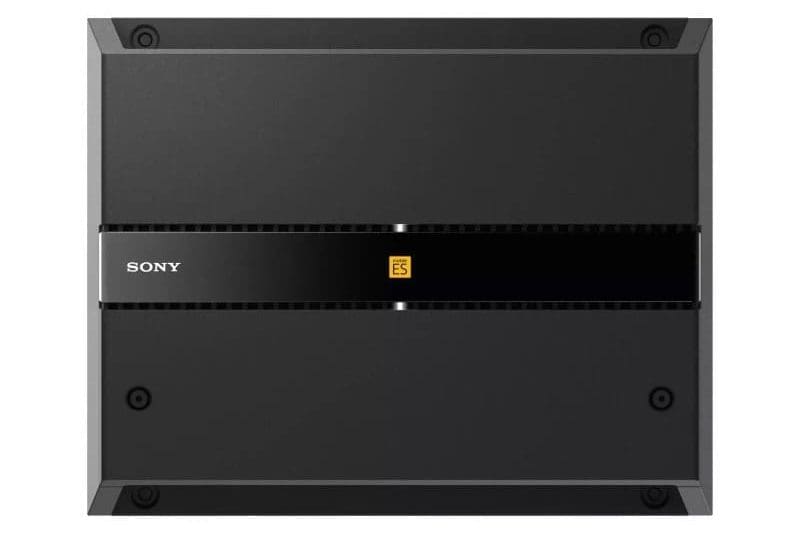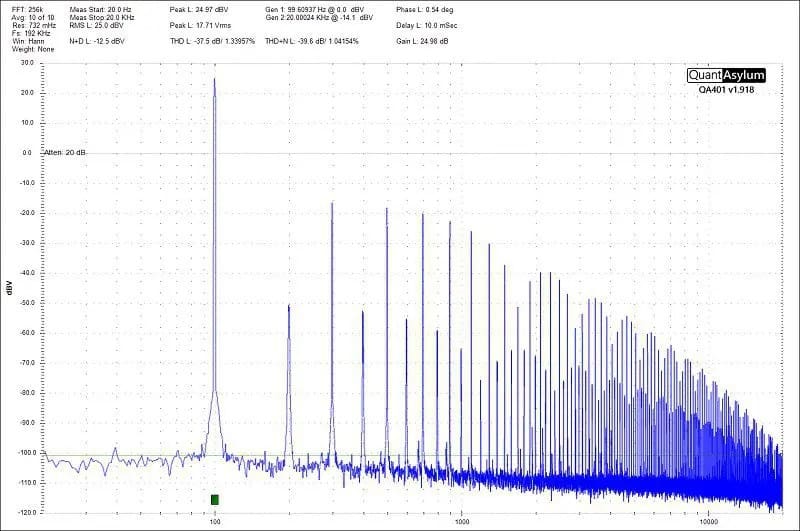The Question of the Month for December brings up the often-discussed topic of subwoofer damage. Specifically, we’ve seen it asked time and time again if you can damage a subwoofer by underpowering it. The answer is a simple no, but the topic is a little more complex than it might seem. Let’s discuss what amplifiers do when they exceed maximum power and what causes damage to a subwoofer.
Amplifier Power Ratings
What do the power ratings on an amplifier tell us? In short, the power rating tells us how much work the signal from the amp can do. More watts of power should translate into more sound from a speaker or subwoofers. To reiterate something we’ve preached many times, power production has nothing to do with signal quality—many high-powered amplifiers on the market sound terrible.
Another important consideration is that not all power ratings are directly comparable. The specifications should comply with the ANSI/CTA-2006-D standard so you can be sure the information is accurate and measured with a repeatable process. An accurate amplifier power rating will tell us how many watts the amp can produce into a certain load, with a specific supply voltage to the amp and a specific amount of distortion. Leaving out the last two quantifying factors makes the power rating effectively useless.



Over-Driving a Car Audio Amplifier
Suppose the technician setting up a car audio system with one of the three amps above knows the client will likely be aggressive with the volume. In that case, they should set the sensitivity (gain) control on the amp to make those 1,000 watts when the volume is cranked and the music is at the highest possible recording level. We refer to the latter as 0 dB FS (full scale). Without turning up the bass control or EQ bands on the radio, this is as much signal as we’ll see fed to the amp.
What happens when the gain is set a little more sensitive than it should be? Perhaps the radio was at volume 48 instead of 50 when the gain was set? Maybe they used a recording that’s 3 dB below the maximum possible recording level. This increase in amp sensitivity now allows the audio system operator to push the amp into a condition where the output signal distorts. We call this clipping, as the tops and bottoms of the audio waveform are chopped off or flattened.




As you can see from the above, additional frequency information is added to the output signal when the amp is clipping. More clipping adds more energy (power) in the added harmonics. Let’s look at that measurement in a completely different way.
Amplifier Power in Distortion Harmonics
The chart below measures how much energy is in the fundamental signal and how much each harmonic adds.
With the amp making about 1% THD+N, the total power in the fundamental frequency band of 100 hertz is 157 watts. The harmonic content is pretty low, so they add only 50 milliwatts of energy to the signal headed for the speaker.
Energy rises everywhere when the output is increased to >10% THD+N. The fundamental now contains 177.4 watts. The extra power in the harmonics is crucial to understanding how clipping damages speakers. The 300-hertz harmonic has another 10 watts. All the harmonics add up to send 187.7 watts to the speaker.
More Power, More Problems
Let’s scale this up to our 1,000-watt amplifier. If it makes 1,000 watts at 1% THD+N, then using the same ~120% multiplier would mean we can easily send 1,200 watts to the subwoofers.
What’s crucially important is that amplifiers can produce much more power when pushed into clipping. The measurements at 10% THD are an arbitrary number. Amps without limiters can easily reach 50 or 60% THD. It’s not unreasonable to see an amp produce 150% of its rated power.
If you purchased subwoofers rated to handle 1,000 watts of power but fed them with 1,500 watts, do you think they’d be happy? The answer is a definite no.
Subwoofer Power Handling Considerations
The ANSI/CTA-42-B R-2011 standard outlines the industry-reference speaker and subwoofer power handling test methodology. The test involves eight hours of playing a subwoofer with a specific bass-heavy test signal. The speaker must continue to function normally after the test for it to pass, and the electromechanical (Thiele-Small) parameters must not change by more than 10%. If the speaker cannot pass this test, it’s not rated accurately.
Most reputable speaker and subwoofer manufacturers will test samples of new drivers at just under the rated power level, say 900 watts, for a 1,000-watt rated subwoofer. If it passes, they let it cool, then repeat the test at something like 950, then 1,000, then 1,050 watts, and so on, until they find a power level that causes irreparable damage. They can publish a power rating where the speaker passes the test.
Power and Heat Are Connected
So, what happens to an object like a speaker’s voice coil when we feed it 1,500 watts instead of 1,000? Well, a little math will give us a clue. Negating the cooling benefits of the magnet, T-yoke, and top plate, a copper cylinder with an inner diameter of three inches, an outer diameter of 3.2 inches, and a total height of two inches has a surface area of 40.90 square inches. For this rough approximation, assume this is the voice coil of a very large subwoofer.
Applying 1,000 watts of heat to that cylinder raised its temperature to about 560 degrees Celsius in one minute. Now, if we increase the heat input to 1,500 watts, the temperature would be almost 840 degrees Celsius after the same amount of time.

Copper melts at 1,085 degrees Celsius, aluminum melts at 660 degrees Celsius, and polyimide adhesives are suitable for temperatures no higher than about 400 degrees Celsius. The adhesives keep the voice coil windings glued together around the voice coil former.
Let’s look at this another way. With 1,000 watts of power, the voice coil analog reaches 400 degrees in 41 seconds. With 1,500 watts of power, reaching the same temperature takes only 28 seconds.
If you’ve ever wondered why a speaker’s voice coils unravel when they are overheated, now you know why. This is also why SPL contest participants can “burp” subwoofers with several times the power the drivers are rated for in short durations.



Does Underpowering a Subwoofer Damage it?
So, back to the original question. Does underpowering a subwoofer damage it? That question is misleading. It implies that less power can cause damage. If so, the speaker in the shipping carton would be at risk. The only risk here is that the courier drops the carton when delivering it to the store you are dealing with.
The real question is: does using an amplifier rated for less than the speaker can handle pose a greater risk of damage? As long as you manage the power from the amp and don’t push it beyond where it starts to distort, once again, no. An audio signal with distortion or frequency content where the total power doesn’t exceed a subwoofer’s continuous rating won’t cause damage. By that logic, distortion, which is the addition of unwanted audio information to a signal, doesn’t directly pose a risk to a subwoofer. Worded differently, distortion doesn’t damage subwoofers.
Those last two sentences are imperative. Please re-read them.
Too Much Power!
What happens if high levels of distortion send a significant amount of additional power to the subwoofer? Well, that is a problem. Anytime the total power exceeds the subwoofer’s rated power, you risk damaging it quickly. Is the distortion the problem, or is the extra power in the added harmonics? It’s the latter. One thousand watts of clean power plus 300 watts of distortion will damage a 1,000-watt speaker. However, it’s not the distortion that’s the issue.
If you switch to a 750-watt amplifier and it adds 250 watts of distortion due to improper level setting, you get 1,000 watts. If the speaker’s specifications are legitimate, it should play for at least eight hours. We are deliberately ignoring suspension limitations in this discussion. Likewise, you could use a 500-watt amplifier and drive it into clipping as hard as you want. That might produce 750 or 800 watts of power. You can play that for hours and hours, and the subwoofer won’t care.
Clipping and distortion don’t damage subwoofers. The Only Thing That Damages Subwoofer Voice Coils is Power


Too Long; Didn’t Read
There are a few critical takeaways from this Question of the Month about underpowering subwoofers. First, amplifiers can produce significantly more power to a speaker than they are rated for. This can be 30 to 50% more than they are rated for. Second, speakers with specifications in compliance with the ANSI/CTA-2031 standard and, by reference, the ANSI/CTA-426-B standard shall be able to play at their rated power level for at least eight hours. Third, there is no such thing as underpowering a speaker or subwoofer—that is equivalent to turning the volume down. Finally, adding unwanted audio content to your music, which would be called distortion due to clipping, isn’t an issue for a subwoofer. However, if anything causes the power going to a subwoofer to exceed the driver’s rating, it can be damaged quickly.
Is the concept of underpowering a subwoofer to cause damage even plausible? No. Not even remotely. If it were, then connecting a 1,000-watt subwoofer to a radio that only produces 20 watts of power would cause damage. Yes, that’s an exaggeration, but you get the point.
The real question is, is a 750-watt amplifier more likely to damage a 1,000-watt subwoofer than a 1,000-watt amplifier? The answer depends on the gain structure of the audio system. If neither amp can be pushed beyond the point where it produces 1,000 watts of power, neither will damage the subwoofer. If there is too much gain overlap in either amp, either could damage the subwoofer.
If your car audio subwoofer upgrade doesn’t play loudly enough and you have the urge to turn up the gains on your amplifier, don’t! Your best bet is to add more drivers or change the subwoofer enclosure. Turning up the gain on your amp will increase the power to the subwoofers, possibly to the point that they can be damaged. Return to the shop that designed and installed the system and discuss your options for more bass. They’ll be happy to help!


